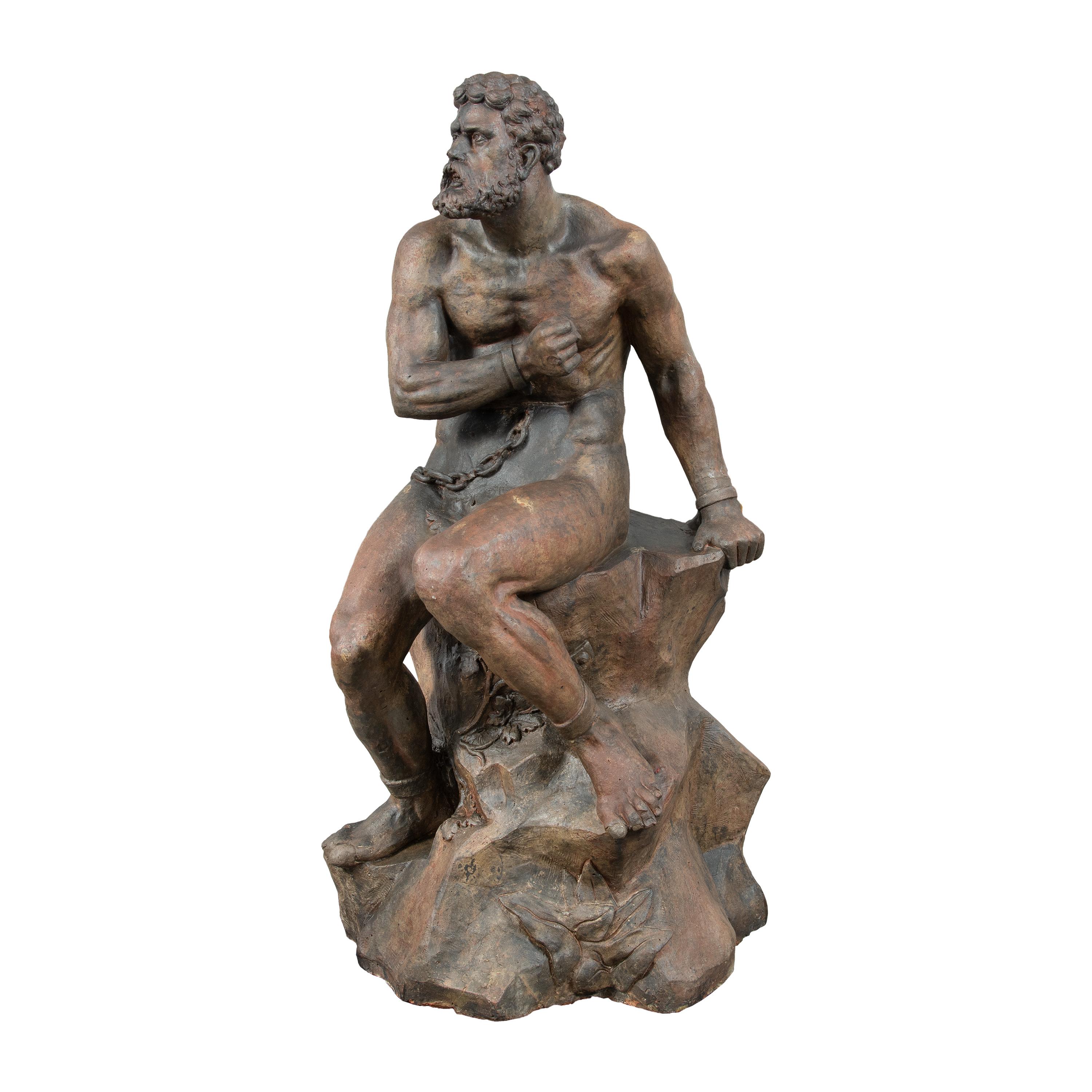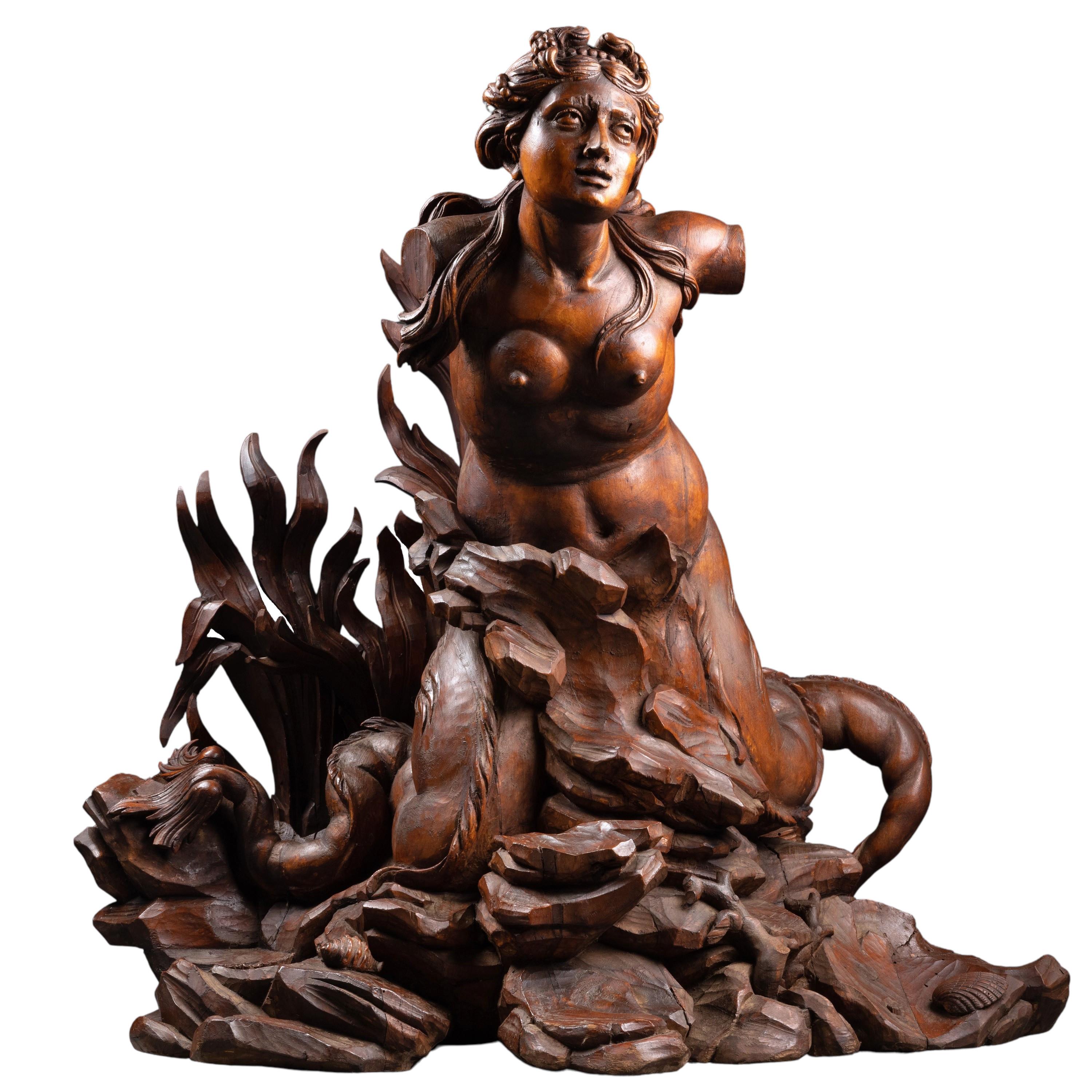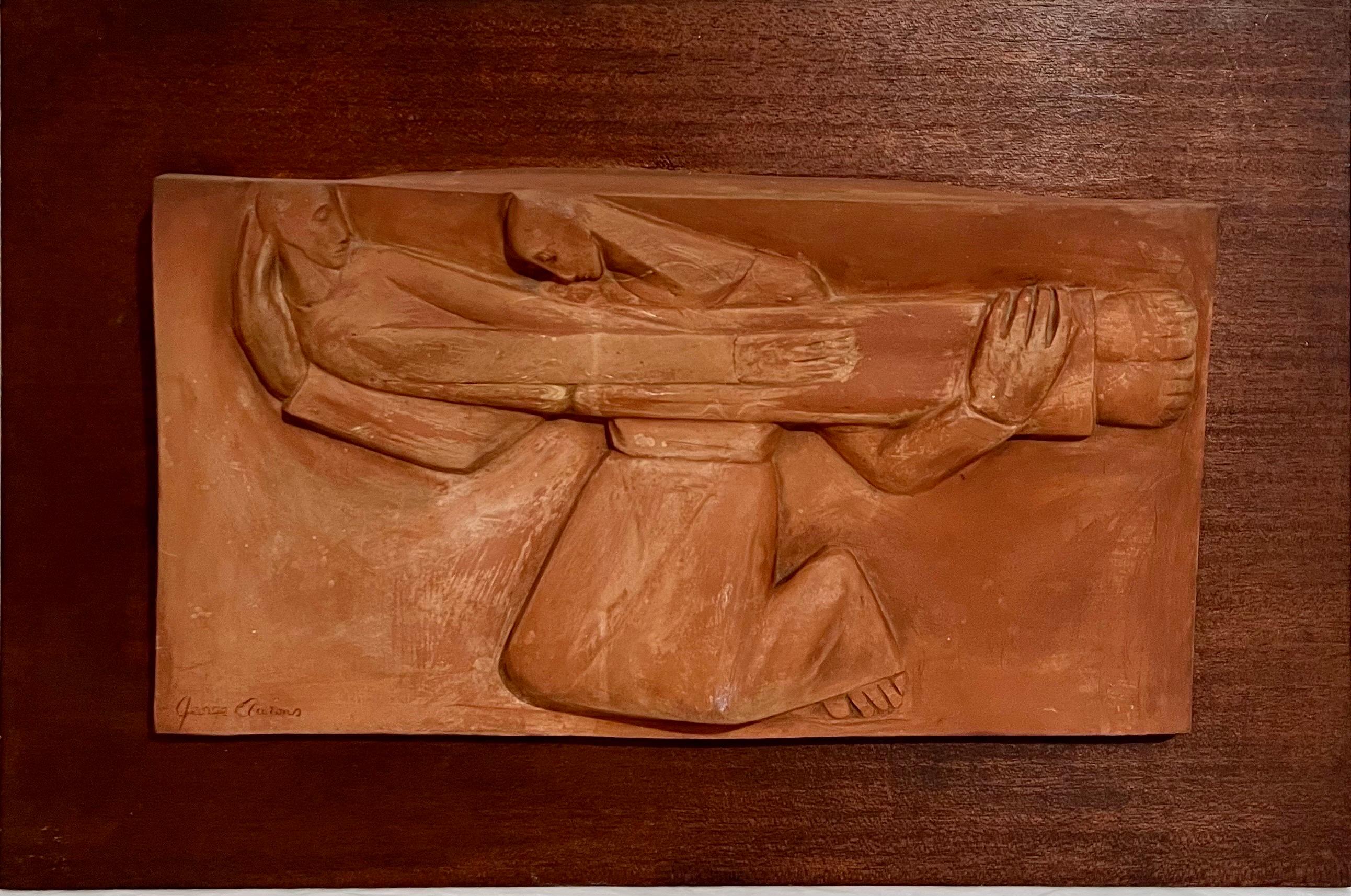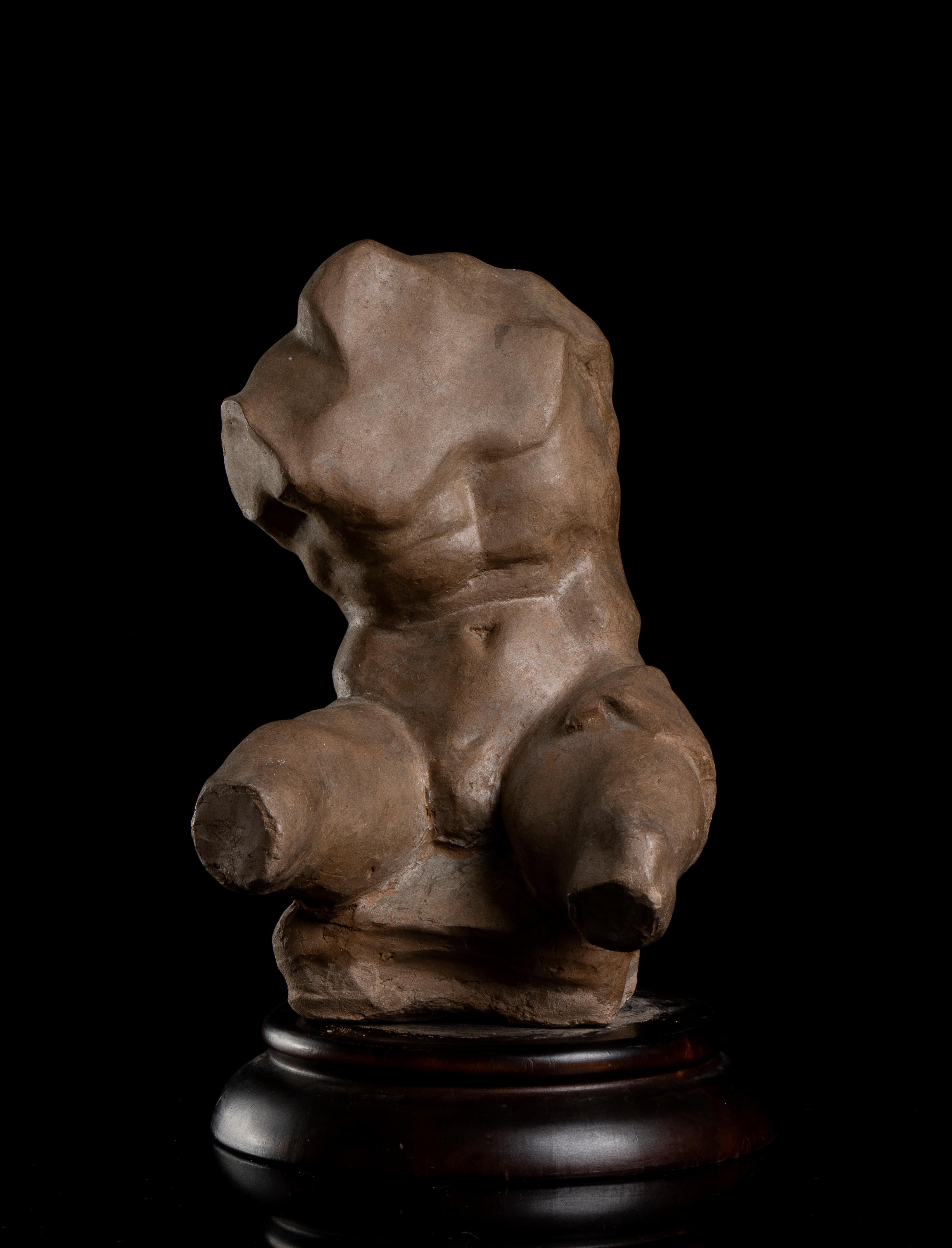Items Similar to "Putti" 19th c. Terracotta, Antique, Mythical Figures, Patina
Want more images or videos?
Request additional images or videos from the seller
1 of 6
Albert-Ernest Carrier-Belleuse"Putti" 19th c. Terracotta, Antique, Mythical Figures, Patina1864
1864
About the Item
SALE ONE WEEK ONLY
“Putti” is a 19th c. terracotta antique of two nude children, babies, as mythical figures. This piece is beautifully rendered with a rich brown patina. Though babies they seem more mature with their decorative flowers and posed as partaking in conversation. Putti are human (no wings) and male (biologically correct). They are not associated with death. So, the Raphael figure, having wings, is no putto. Second, winged genderless children are cherubs, or more properly, cherubim. This piece is signed by the sculptor and his marks, fingerprints, are on the base of the sculpture which sits on a beautifully carved wooden plinth.
Carrier-Belleuse had a sharp sense of how to combine historical elements with new technologies and the process of mass production. In his workshop, students like Auguste Rodin learned the value of series, editions, and variations made alongside unique, monumental Salon submissions.
Albert-Ernest Carrier-Belleuse (born Albert-Ernest Carrier de Belleuse) was a French sculptor, one of the founding members of the Société Nationale des Beaux-Arts, and an officer of the Legion of Honour. He attended the National School of Fine Arts and began his training as a goldsmith's apprentice. In 1840 Pierre-Jean David d'Angers sponsored him for the École des Beaux-Arts. He stayed only briefly, moving to the Petite École to study decorative arts instead. While at the Petite Ecole in the 1840s, Carrier-Belleuse began his lifelong practice of providing commercial houses with models for edition, as statuettes or as ornament for functional pieces. Between 1850 and 1855, Carrier-Belleuse worked in England, designing ceramics and metalwork models for companies like Wedgwood Minton Chica Works at Stoke-upon-Trent, Coalbrookdale Ironworks and Graham & Jackson furniture makers. Even after returning to Paris in 1855, he continued to send models to British firms throughout his life. From 1857 he exhibited large-scale sculptures at the Salon, where he garnered medals and commissions from important patrons. Emperor Napoléon III employed him in public projects during the massive rebuilding of Paris from 1851 to 1870.
His work encompassed all manner of sculptural subjects and materials, and his naturalism incorporated a breadth of styles: unembellished Realism, neo-Baroque exuberance, and Rococo elegance. He consistently opposed, however, the static poses and idealizing tendencies of Neoclassicism. His torchères for the Paris Opéra were typical: he combined figures inspired by sixteenth-century sculptors with electrotyping, a new process for replicating three-dimensional objects. Beginning in 1876 Carrier-Belleuse revitalized the Sèvres porcelain manufactory as its artistic director.
He began to garner acclaim as a fine-arts sculptor after ten years of showing in the Salon, beginning with two portrait medallions in 1850 and a flurry of busts and groups with mythological or historical subjects between 1857 and 1861, the latter of which earned him a third-class medal. Carrier-Belleuse finally received serious attention in 1863, when the emperor bought his marble Bacchante from the Salon for the Jardins des Tuileries (Musée d'Orsay, Paris). Four years later, his marble Messiah was purchased by the State from the Salon of 1867 and allotted to Saint-Vincent-de-Paul in Paris; it earned him a Medal of Honor and the cross of the Légion d'Honneur. From that time onward, Carrier-Belleuse was established internationally as a high-art sculptor as well. He produced abundantly for a variety of international patrons in most categories of three-dimensional work--public monuments, for example, Masséna (1867, Nice), allegorical reliefs for Parisian buildings (Palais des Tuileries and Banque de France, 1865-1866), tombs for foreign heroes (San Martín Cathedral, Buenos Aires, Argentina), and classicizing figure subjects such as Sleeping Hebe for the Salon (1869, marble; Musée d'Orsay, Paris)--while simultaneously maintaining high visibility in the applied arts.
Carrier-Belleuse raised a critical hue and cry during his lifetime with his sensuous female nudes, especially Angélique, shown in 1866 (marble, lost; reduced terracotta variant, private collection). Broadly in the vein of nineteenth-century "voluptuous antiquity," the work pursues more realism and seductive materiality than Pradier's classical women through their violently sinuous movement and polychromy. Like Auguste Clésinger (1814-1883), who had riveted Paris in 1847 with his Woman Bitten by a Snake (Musée d'Orsay, Paris), Carrier-Belleuse violated the idealist canon of pure marble by adding real jewelry of his famous contemporaries such as Froment-Meurice. However, the sculptor applied his enormous capacity for modeling and design to a variety of stylistic and expressive modes. The neo-baroque realism of his heroic monuments differs signally from the neo-rococo preciousness, material richness, and vivacity for which he is best known. Yet he explored few expressive extremes outside the dionysiac. Open violence and pathos are rare in his work; his most typical expressive mood was the intimate and wittily spirited. He consequently gave varied and winsome life to historical figurines and fantasy busts, and was a masterful portraitist. His prolific portraiture of both men and women is often compared to Houdon's, as it similarly conveys extraordinary likeness and psychological life within richly tactile, modeled work. For all his association with rococo sensuality, Carrier-Belleuse's mastery at articulating form gave as much vitality and appeal to the marbles carved from his models as to his many works in clay and bronze.
The sculptor sold finished serial work directly through his studio and at auction, and thus counted among the most actively entrepreneurial of his fellow professionals, like Jean-Baptiste Carpeaux and his senior, the animalier Christophe Fratin. His models and published designs integrated the human figure within functional forms--torchères and table service, for instance--in a variety of styles, and with imagination and verve; they were commercially successful and influential for decades. Carrier-Belleuse was appointed director of works at the state Manufacture de Sèvres in December 1875, where he greatly improved the quality of the models and expanded production in biscuit. A charter member of the new professional organization for the applied arts (the Union Centrale des Beaux-Arts Appliqués à l'Industrie), founded in the early 1860s, he was enormously important in elevating the stature of the applied arts and for the sheer quality of his ornamental design. For that contribution to France alone the artist was promoted to officer of the Légion d'Honneur in 1885. Thanks to his huge studio production and responsibilities at Sèvres, he had considerable impact on the art and careers of younger sculptors who worked for him, notably Auguste Rodin, whether in Paris or in Brussels, where both moved during the Franco-Prussian War of 1870-1871.
- Creator:Albert-Ernest Carrier-Belleuse (1824 - 1887)
- Creation Year:1864
- Dimensions:Height: 12 in (30.48 cm)Width: 17 in (43.18 cm)Depth: 7 in (17.78 cm)
- Medium:
- Movement & Style:
- Period:
- Condition:
- Gallery Location:Detroit, MI
- Reference Number:1stDibs: LU128616361932
About the Seller
5.0
Gold Seller
These expertly vetted sellers are highly rated and consistently exceed customer expectations.
Established in 2014
1stDibs seller since 2019
95 sales on 1stDibs
Typical response time: 3 hours
- ShippingRetrieving quote...Ships From: Detroit, MI
- Return PolicyA return for this item may be initiated within 14 days of delivery.
More From This SellerView All
- "Emerging First Man" Bronze Sculpture, Male Figurative, Ceramic Shell, ResinBy Artis LaneLocated in Detroit, MIAll my life I have worked on three levels of consciousness: Portraits, Social Injustice & Metaphysics. In my work I strive to heal, uplift and inspire viewers and collectors to find ...Category
1990s Contemporary Figurative Sculptures
MaterialsBronze
- "New Woman" Bronze, Frontal Nude Female, Figurative SculptureBy Artis LaneLocated in Detroit, MI"New Woman" is an iconic portrait of a female woman. Her work has been described as follows: "Lane captures the body in various poses, depicting the movement and fluidity of living i...Category
1980s Contemporary Figurative Sculptures
MaterialsBronze, Metal, Steel
- "Rebirth" Bronze Sculpture with Patina, Figures, Naked, MaleBy Artis LaneLocated in Detroit, MIAll my life I have worked on three levels of consciousness: Portraits, Social Injustice & Metaphysics. In my work I strive to heal, uplift and inspire viewers and collectors to find ...Category
1990s Contemporary Figurative Sculptures
MaterialsBronze
- "Birth" Sculpture, Bronze with Black Patina, Female, NudeBy Artis LaneLocated in Detroit, MI"Birth" is a small intimate sculpture of a women in the act of pending birth. She gazes skyward beyond her own condition of birthing an earthly being, to encompass the intellectual a...Category
Late 20th Century Contemporary Nude Sculptures
MaterialsBronze
- "Woman" Bronze Sculpture with Patina, Female NudeBy Artis LaneLocated in Detroit, MIAll my life I have worked on three levels of consciousness: Portraits, Social Injustice & Metaphysics In my work I strive to heal, uplift and inspire viewers and collectors to find p...Category
Late 20th Century Contemporary Figurative Sculptures
MaterialsBronze
- "First Man" Bronze with Black Patina, Nude Male SculptureBy Artis LaneLocated in Detroit, MI"First Man" is a contemplative figure of an nude man with his hands clasped together and his head thrown back suggesting an individual deep in spiritual thought. Ms. Lane has stated ...Category
Late 20th Century Contemporary Nude Sculptures
MaterialsBronze
You May Also Like
- Baroque master sculptor - 18th century terracotta sculpture - Prometheus figureLocated in Varmo, ITTerracotta sculpture - Prometheus - Italy, 18th century. 48 x 50 cm x h 94 cm. Entirely in terracotta. - All shipments are free and professionally packed. - This item is sold wit...Category
Early 18th Century Baroque Figurative Sculptures
MaterialsTerracotta
- A late 17th Italian carved limewood figure of Mermaid, circle of Filippo ParodiLocated in PARIS, FRA late 17th c. Italian carved figure of Mermaid, Circle of Filippo Parodi (Genoa, 1630 – July 22, 1702) Dimensions: h. 29.13 in, w. 30.31 in, p. 18.9 in (at the base) Magnificent...Category
Late 17th Century Baroque Figurative Sculptures
MaterialsWood
- Tuscan Baroque Nude Putto Candle Holder 17-18 century gilded woodLocated in Florence, ITOne flame candle holder putto made of gilded wood. Those kind of objects were present in churches or noble villas, specially during the Baroque times. The base is not coeval.Category
17th Century Baroque Nude Sculptures
MaterialsGold
- Large George Aarons Terracotta Sculpture Relief Art Deco Plaque WPA ArtistBy George AaronsLocated in Surfside, FLTwo Figures (Mother and son) 9" x 17" terracotta sculpture, signed lower left mounted to wood panel, 15 1/2" x 23 1/2" George Aarons (born Gregory Podubisky, in St. Petersburg, Russ...Category
20th Century Art Deco Figurative Sculptures
MaterialsWood, Terracotta
- Sculpture Torso Belvedere Grand Tour Style 19th Century Terracotta AcademicalLocated in Roma, ITa very interesting sculpture, a studio of the Belvedere Torso made in french in the 19th Century. Standing on a double order circular wood base, the sculpture present an harmonic and...Category
19th Century Other Art Style Figurative Sculptures
MaterialsTerracotta, Wood
- French Terracotta Sculpture Studio Torso Belvedere Grand Tour Style 19th CenturyLocated in Roma, ITa very interesting sculpture, a studio of the Belvedere Torso made in french in the 19th Century. Standing on a double order circular wood base, the sculpture present an harmonic and...Category
19th Century Other Art Style Figurative Sculptures
MaterialsTerracotta, Wood
Recently Viewed
View AllMore Ways To Browse
Antique Patina
Antique Wood Patina
Art Four Antiques
Antique Putti
Antique Wood Figures
Antiques Association
Wooden Figures
Antique New England Art
Alberts Antiques
Antique Sculpture Table
Nude Woman Sculpture
Marble Sculpture Nude
Large Nude Sculpture
Antique Wood Carved Figures
Sculpture Of Nude Woman
Nude Male Furniture
Antique Classical Sculptures
Male Female Figures





